There have been a number of design considerations put into wind turbines, both on-shore and off-shore, one of which is the number of rotor blades.
A stereotypical wind turbine is designed to feature three rotor blades. This design consideration has to do with aerodynamics (drag), stability of the turbine, and cost efficiency. Having fewer blades reduces drag, but a two blade design results in "wobble" when motors turn the nacelle to face the wind (yaw). Single-blade turbines have no stability.
While two and three blade turbines are the most common, it's important to understand why three rotors are used. Note that advances in technology are even exploring bladeless designs.
Table of Contents
Designing a Wind Turbine
The overriding consideration that determines what makes a good wind turbine is efficiency. A good wind turbine is one that can generate the most amount of energy for the least amount of money.
If you have a blank piece of paper and you’re designing a wind turbine, you want to capture as much kinetic energy from the wind as possible and transfer it into the rotor to drive the generator.
Blade aerodynamics math dictates that optimal wind capture is dependent on three things – number of blades, speed of rotation, and width of the blades. A turbine can operate optimally with any number of blades - just by adjusting the speed they rotate and/or the width of the blades to compensate. The more blades you add to the turbine, the thinner they need to be. Likewise, with fewer blades, they have to be made thicker to maintain optimal efficiency.
Due to fluid dynamic effects around the blade tips, there are marginal aerodynamic advantages from using a larger number of thinner blades, as thicker blade tips create more significant efficiency losses.
Drag and Lift
Lift and drag are two aerodynamic effects that are utilized by wind turbine blades. The cross-section of a turbine blade is shaped like an aircraft’s wing, so that as wind passes over the blade, lift causes the blade to rotate quicker due to the aerofoil effect.
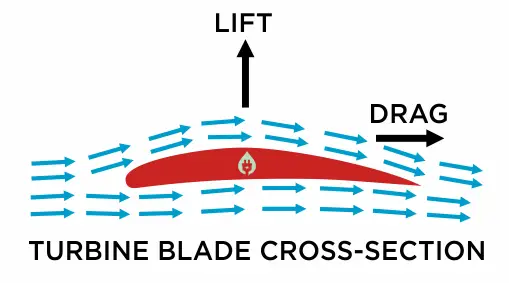
Each blade also creates drag, causing the turbine to slow down as wind passes over it. So, in principle, the fewer blades the better, since there will be less drag, and an increase in efficiency.
However, if there is too little drag, the turbine may spin too fast in higher winds, and risk damaging itself.
To keep the rotation speed of the turbine down to a safe level, the amount of overall drag can be tuned by adjusting the thickness of the blades – thinner blades create less drag, and thicker blades create more drag. The problem is that blades cannot be made too thin, or they will not be strong enough and break when the wind speed is high.
Rotational Speed
The rotation speed of the turbine is constrained by a couple of factors:
If a Turbine Rotates Too Fast, it Will Literally Rip the Blades Apart
Once the centripetal forces in the blade exceed the tensile strength of the material it is made from, the blades will start to shred. Modern turbine blades are usually made from glass fibre or carbon fibre due to their very high tensile strength.
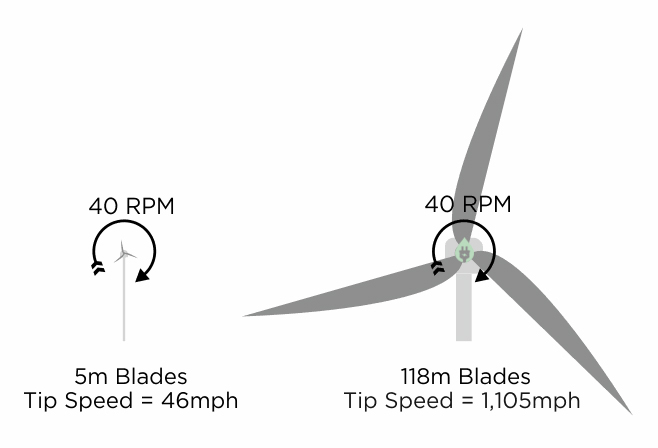
The larger the wind turbine, the faster the blade tip speed will be for a given rotational speed. If you consider a turbine rotating at 40rpm (1.5 seconds for a full rotation), and the turbine’s blades are 5m long, the tips will be sweeping through the air at about 46mph.
The world’s largest wind turbine is the Vestas V236 15MW turbine, which has a blade length of 118m. If this turbine rotated at 40rpm, the blade tips would be travelling at about 1,105mph. This is faster than the speed of sound (761mph), and would cause sonic booms, and increased stress on the blades, which is not desirable (see diagram above, blade lengths shown to scale).
Consequently, to allow for such large turbines, an operational rotation speed has to be selected that is low enough to keep the blade tip speeds down to subsonic speeds, and yet as fast as possible for maximum efficiency.
The Faster the Blades Go, the More Noise They Make
This is not so much an issue for off-shore wind turbines, but if on-shore wind turbines make too much noise, they will cause a disturbance to residents nearby, who would object to their construction.
For this reason, an optimal rotation speed is selected first when designing a wind turbine, and then the blade thickness / drag / number of blades is worked out backwards from that.
Single Blade Turbines
Some attempts have been made at single-blade turbine designs, using a counterbalance opposite the blade to keep the turbine stable as it rotates. The basic reasoning behind them is that with only one blade, there is the least amount of drag, so the turbine will be more efficient.
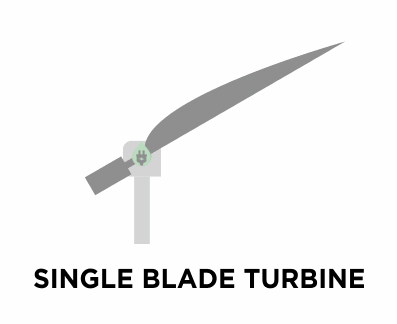
However, this design adds unnecessary weight and blade hinge complexity for no aerodynamic advantage. Also, to achieve optimum efficiency, it has to turn faster than an equivalent two- or three- blade design, creating more noise. This design and has now, by and large, fallen into disuse.
Two Blade Turbines
At first glance, two bladed turbines seem like the optimal configuration for a wind turbine. Perfectly balanced, and with one blade less than a 3-bladed turbine, they will generate less drag. So why aren’t all turbines made with two blades?
Two blade turbines have problems when yawing. Yaw is what a wind turbine does when its head (or nacelle) turns to face the wind.

Due to an effect called gyroscopic precession, when a 2-blade turbine yaws, it creates a wobble as the blades go from the vertical plane to the horizontal plane, which places additional stresses on the mounting bearings, wearing them down faster.
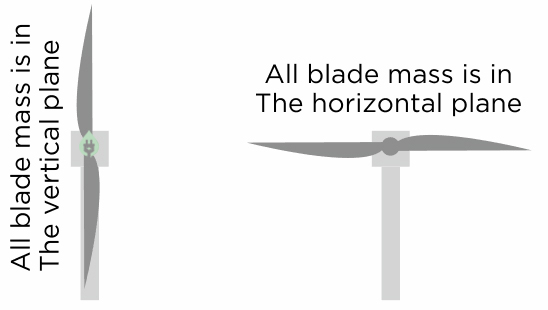
In turbines with 3 or more blades, the blade masses are distributed evenly across the horizontal and vertical planes, no matter what position the blades are in, and so they do not suffer this wobbling gyroscopic effect.
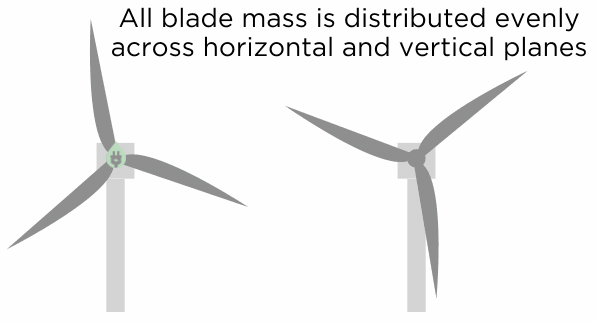
Manufacturing and Construction Constraints
Once a turbine has been designed, it has to be manufactured, transported, and then assembled on site. All three of these steps have to be carefully considered as part of the design process - there’s no point designing a perfect turbine if it is not possible to actually manufacture it or move it to where it needs to be!
This makes designing any turbine a compromise – balancing the practical manufacture, transportation and assembly constraints with theoretical optimal design specifications.
Manufacture
As mentioned earlier, the blades cannot be manufactured too thin, or they will break under high winds. The carbon fibre / glass fibre materials that are used to make the blades are expensive, so the fewer blades the better, as this reduces cost. This means that 3 blades is chosen – any less and the turbine will experience gyroscopic wobble; any more and the manufacturing costs will be higher.
Transportation
Planners have to identify an appropriate road route that doesn’t have sharp bends that can be used to move the turbine blades from the factory to the site. The roads have to be of sufficient quality to handle the weight of the specialist trucks and the blades themselves. The logistics of turbine blade transportation planning has become a serious issue in recent times, being specifically addressed in the 2017 book Transport Infrastructure and Systems.
Assembly
Once the components have arrived at the construction site the main tower is erected first, and the nacelle mounted on top. The blades are lifted and attached to the nacelle, which, allowing for 30m clearance, could be as high as 148m from the ground in the case of the Vestas V236.
On-shore turbines use mobile crane platforms like the Liebherr LG1750, which has a maximum lift weight of 750 tonnes and can lift to 193 metres. Off-shore turbines are assembled using specialist floating platforms with cranes mounted onto them. These platforms can be sailed like ships to the site, and then jack themselves out of the water to provide a stable base from which to assemble the turbine.
Learn More: The Different Types of Wind Turbines
Bladeless turbines?
Theoretically, a turbine with no blades (or blades of zero thickness!) would eliminate drag completely, and thereby operate at maximum efficiency.
While blades of zero thickness are physically impossible to manufacture, at least one bladeless design has been brought to market. This does not have blades and a rotor like a traditional turbine, but rather it uses a process called vortex-induced resonance to extract kinetic energy from the wind using a vertical pillar. As the wind passes the pillar, it causes turbulence behind it, which causes the pillar to oscillate or ‘vibrate’ back and forth, and it is this mechanical energy that drives a linear alternator, thus generating an electric current.

